Baseball's dirty little secret is out. We decided to experiment
The menu options were laid out before me, like stepping up to the counter of a Chipotle for cheaters.
Inside the netting surrounding the indoor bullpen at Performance Velocity Systems, a baseball training center in the southern hills of Pittsburgh, was an assortment of grip-enhancing substances.
On the plywood pitching mound was a container of pine tar; aerosol cans of BullFrog sunscreen and Cramer Firm Grip; and in a shallow, circular container of something called Spider Tack, a super-sticky paste developed to help grip Atlas Stones in strongman competitions. There was also a bag of rosin, a ubiquitous sight on major-league mounds.
While rosin is legal, when mixed with BullFrog or pine tar, it's said to create a performance edge. They are the kind of substances commonly found near major-league dugouts and in bullpen bags, according to sources familiar with such practices. They make their way to the pitchers' ball caps, gloves, and belts, and ultimately their fingertips. For Major League Baseball, foreign substances are becoming more of a problem.
After umpire Joe West confiscated St. Louis pitcher Giovanny Gallegos' ball cap due to a visible stain last week, Cardinals manager Mike Shildt ranted to reporters about MLB's policing of foreign substances. Shildt called sticky stuff baseball's "dirty little secret." He called out some of the secrets by name.
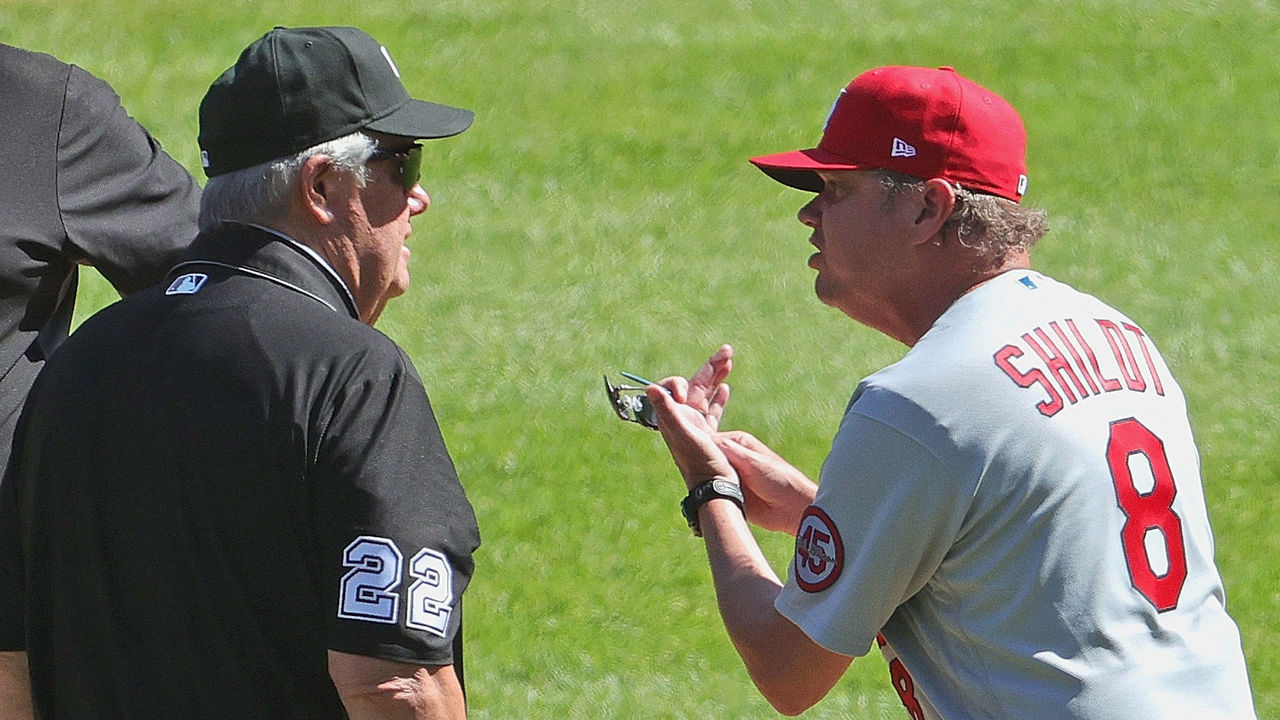
"You want to police some sunscreen and rosin? Go ahead. Get every single person in this league," Shildt said. "Why don't you start with the guys that are cheating with some stuff that's really impacting the game? … Let's go check the guys that are sitting there going to their gloves everyday with filthy stuff coming out."
I was here in Pittsburgh a few days before the Cardinals' kerfuffle to experiment and understand more about baseball's sticky situation. I was curious to see how different kinds of substances helped performance. Helping me with the research were two college arms in the transfer portal: Tom Colcombe, most recently of the University of Pittsburgh, and Spencer Curran from Seton Hill University, which is in nearby Greensburg, Pennsylvania.
I asked Curran how I should apply the Spider Tack.
"Very carefully," he said.
I dipped my right index finger into the container and the substance immediately took hold. As I slowly moved my hand away from the jar, the Spider Tack refused to let go. A long band stretched from the jar to my index finger, like bubble gum stuck to the sole of a shoe.

I worked an eraser head's worth of Spider Tack into my right thumb, index, and middle fingers until it felt absorbed. I reached for a ball out of a five-gallon bucket and stepped to the homemade pitching mound. My fingers were now flypaper.
"He's got 60 (mph) in him," hollered Matthew Pilewski in a half-encouraging, half-kidding manner, noting my pathetic velocity. Pilewski runs the place.
I dug my right foot in against the rubber, raised my left leg, tried to keep my arm stroke short, and moved forward, throwing as hard as I could. The ball sailed close enough to the strike zone to register on the Rapsodo tracking device near the plate that measures various spin and velocity characteristics.
"I heard that," Pilewski said of the ball becoming unstuck off my fingertips.
"I heard that, too," Curran said.
We looked up at the screen mounted on the wall showing the Rapsodo readings.
"That's nuts!" Pilewski exclaimed.
Pitchers have always applied substances to try and gain an edge. Unless blatantly abused, umpires rarely bother enforcing the rulebook. Managers seem fearful of accusing opponents knowing they have cheaters on their own staff. Mutually assured destruction results in a silent detente. However, in recent years, pitch-tracking data collected and shared publicly by Major League Baseball is uncovering just how much adding spin helps.
How much? A lot. Since the start of last season, batters are hitting .264 on four-seam fastballs that range from 2,250-2,350 rpm, a league-average range, and .217 against fastballs with greater than 2,500 rpm of spin.
More spin means more Magnus effect, which is the invisible force governing most pitch movement. More spin results in breaking pitches that break harder and fastballs that defy gravity just a little longer. That means weaker contact and more strikeouts. With the power of sticky stuff now quantified in hard data, it's only incentivized major-league pitchers to experiment. Spin rates and strikeouts are on the rise to record levels nearly every season. Batters are flirting with a historically low average this season.
One could argue the greatest way for MLB to reduce strikeout rates and get more balls in play is to enforce its own rulebook and crack down on pitchers using foreign substances.

MLB issued a memo this spring warning pitchers it was serious about the issue, though there have been no punishments to date for major-league arms. The league is collecting suspicious balls this season for analysis, along now with Gallegos' hat. It remains to be seen how MLB handles the issue. Four minor-league pitchers were suspended this week for using foreign substances.
"The increased monitoring and inspection process in addition to the spin rate analysis outlined in the March 23rd memo sent to clubs are in effect," an MLB spokesperson wrote to theScore in an email. "The central office data collection is ongoing."
Every jar of Spider Tack is a proverbial can of worms. To get more balls in play, should baseball monitor pitchers more closely and penalize offenders before doing something radical like moving the mound back? For pitchers (and for batters worried about being hit by increasingly faster pitches), is there a substance beyond rosin that provides better grip and safety without dramatically increasing spin?
In a back and forth on Twitter last week, Twins third baseman Josh Donaldson tweeted to former pitcher Dallas Braden about sticky stuff: "Crazy idea here but I'm going to throw it out there. Stop cheating!!"
Braden countered, noting there are degrees of sticky and there's no precedent or clear way forward in how to enforce foreign substance violations.
I agree. I have an entire catalog of video of these guys cheating it's coming out.
— Josh Donaldson (@BringerOfRain20) May 27, 2021
To get inside this issue and understand the nature of these substances, I got my hands dirty in a converted Pittsburgh warehouse.
Finding Performance Velocity Systems was a bit of a challenge. It's tucked behind an office building with no sign adorning the beige, cinder-block exterior. I called Pilewski and he appeared at the door, waving. The space was previously used to house the sports car collection of a local real estate developer. It was a true garage start-up.
The interior reminded me of other training facilities that changed players' careers and ushered in sweeping changes to development practices in pro baseball. Players don't need much space to get better, whether it's to add velocity, to change a swing, to shape a pitch - or to learn what substances to use. There's just enough room here for one full-length bullpen, and a couple of batting cages where weight training and stretching equipment competed for real estate.
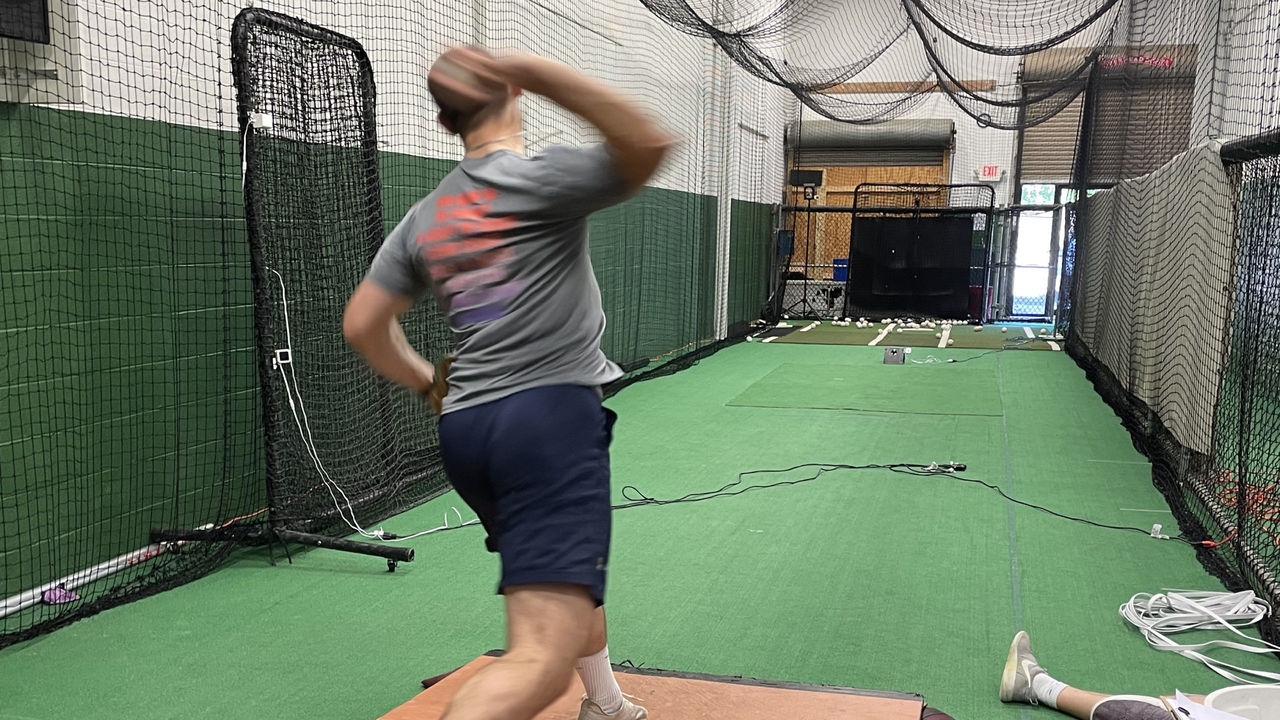
The requisite green artificial turf covered the floor, and new fluorescent lights buzzed overhead. Pilewski upgraded the lighting to get better images from his high-speed cameras.
The facility's existence speaks to the growing foothold data-based development is gaining. Its origin dates back to August 2014 when Pilewski’s son, Joey, suffered an elbow injury while trying out for a travel team. It required surgery and Pilewski felt guilty.
“Did I do this? Did he play too much?" Pilewski said he often asked himself. "So I kind of gave myself a PhD in all things that make a good athlete. … I discovered everything I thought I knew was wrong. Once I was willing to accept that, I became very curious, academically, in a way I never was as a younger man."
He sought a data-based approach to training better ways to throw, so other amateur players could better avoid injury and improve their skills. He began experimenting with things he was finding in scientific journals, and an obscure message board where pioneers like Kyle Boddy and Eric Cressey were regular posters in the early 2010s.
Pilewski opened his facility in 2016. He replaced conventional coaching orthodoxy with a feedback loop of high-speed images and ballistic data on pitches. As far as the kids training here were aware, it's the only facility with a Rapsodo spin-tracking device in western Pennsylvania, other than the Pirates' at PNC Park.
Before we dipped into the substances, I needed to establish my spin and velocity baselines. I can't recall the last time I felt so self-aware.
The mound seemed higher than 10 inches, and the plate further away than 60 feet, 6 inches. Moreover, there were the eyes watching me. It was the same familiar feeling of trying not to shank a drive on the first tee on a busy weekend morning at the local municipal golf course.
"You don't need to throw strikes but it needs to be close," Pilewski said, seated nearby with an iPad linked to the Rapsodo.
That didn't ease the pressure.
I followed the two college players, who were in the low and upper 80s with their fastballs. I wouldn't come close to that, but I needed to throw at least 55 mph and near enough to the strike zone to be recorded by Rapsodo.
With a clean right hand, I reached into the bucket and grabbed a baseball. I placed my right foot against the rubber and pushed off.
The ball tracked near enough home plate to be recorded. Executing what appeared to be a strike in front of the small audience provided a rush of dopamine. I pivoted to the flatscreen on the wall and saw the results of the throw appear: 56.1 mph and 1,440 rpm.
"That's some weak shit," I said.
With a few throws, we established I possessed an average fastball velocity of 56 mph, peaking at 59 mph. My spin rate landed in the mid 1,400s. What we were really interested in was to see how the rpm/mph ratio would change with various substances.

There are only two known, certain ways to increase spin: more velocity or sticky stuff. Even baseball's go-to physicist, Dr. Alan Nathan, told me he doubts there's much a pitcher could do with his grip to increase his fastball spin rate naturally. Grip changes do influence breaking ball spin rate, but trainers at Driveline Baseball in suburban Seattle found it was nearly impossible to increase rpm/mph ratios for fastballs without more velocity or sticky stuff. They dubbed the rpm/mph measurement the "Bauer Unit" because their first MLB client, Trevor Bauer, was so interested in experimenting with it.
My fastball rpm/mph ratio of 25.7 was not much different from this season's major-league average of 24.8.
Curran's baseline was 24.1 rpm/mph, as his fastball sat between 86 and 87.5 mph with between 2,016 and 2,090 rpm. Colcombe's baseline was 22.6 rpm/mph, with his fastball registering from 82.9 to 84.1 mph.
I didn't bother trying to throw a breaking ball, but Colcombe ripped off a baseline slider with 2,058 rpm, good for a 26.9 rpm/mph spin ratio. Curran throws more of a slurve and one of his baseline offerings reached 2,033 rpm, good for a 27 ratio.
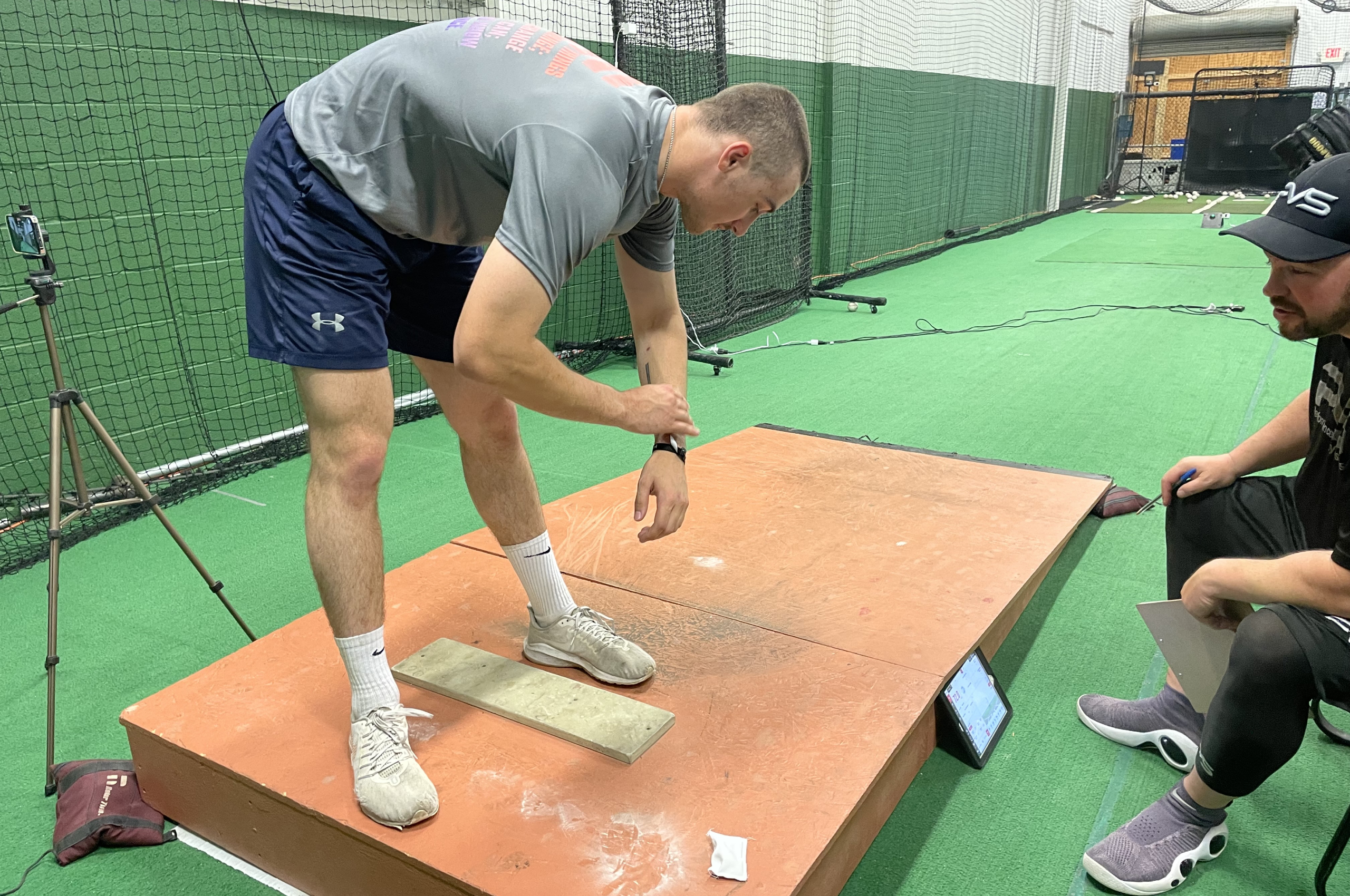
Spin rate continues to climb at the major-league level.
It's increased most years of the Statcast era, to a record-high four-seam rate of 2,319 rpm this year. That's in part because velocity keeps increasing. But the rpm/mph ratio is also increasing, which shouldn't happen - unless more pitchers are using sticky stuff or pitchers are optimizing the sticky stuff they're already using. MLB's four-seam fastball rpm/mph ratio continues to inch up from 24 in 2015, to 24.3 in 2018, to 24.8 this year.
Pitchers like Gerrit Cole and Bauer curiously increased their fastball spin rates dramatically in recent years, helping vault them to elite status among starters.
Ironically, Bauer blew the whistle on substance usage back in 2018, apparently proving his point in one game, and calling the performance benefits greater "than steroids." In 2020, he began enjoying his own spin-rate spike. MLB confiscated game balls from at least one Bauer start this season.
Cole was named by former Angels clubhouse attendant Brian "Bubba" Harkins as one of a number of MLB pitchers who used a special concoction of sticky stuff he created. Harkins was fired by the Angels after the club learned through an MLB investigation that he was supplying this substance to pitchers.
A January 2019 text exchange between Cole and Harkins was submitted to Orange County Superior Court in January as evidence Harkins was, as his attorney claimed, made a "public scapegoat."
"Hey Bubba, it's Gerrit Cole, I was wondering if you could help me out with this sticky situation," the pitcher wrote, adding a wink emoji. "We don't see you until May, but we have some road games in April that are in cold weather places. The stuff I had last year seizes up when it gets cold."
In his three Statcast-tracked years with the Pirates from 2015-17, Cole's four-seam fastball averaged between 2,155 and 2,184 rpm. He posted a 3.52 ERA in that span. In his first year in Houston in 2018, his spin rate jumped to 2,379. Also in Houston then was spin-rate king Justin Verlander, another player Harkins named as using sticky stuff. Cole's spin rate has continued to rise - it's been above 2,500 rpm every year since 2019. Since hiking his spin rate, he owns a 2.60 ERA. His fastball went from being crushed in 2017 to nearly unhittable.
Gerrit Cole's fingers literally stick to his hat here... Bro... 😂 pic.twitter.com/eYzAkHbtaF
— Lance Brozdowski (@LanceBroz) August 8, 2020
While fastballs are spinning more than ever, breaking balls are typically the greatest swing-and-miss pitches in baseball.
Consider that the average slider spin rate this year sits at a tracking-era record of 2,458 rpm compared to 2,106 rpm in 2015, even though the average velocity declined slightly by 0.3 mph in that span to 84.7 mph this year. That's a rpm/mph jump from 24.8 to 29.
Curveballs? A similar story. They're averaging a record 2,553 rpm this year, up from 2,303 in 2015. The Bauer Unit ratio? It's 32.2 rpm/mph this year compared to 29.3 in 2015. In examining FanGraphs' pitch movement data, curveballs are dropping more and fastballs are rising more than ever before.
The game is taking notice. During quarantine, Pilewski held a physics of baseball Zoom class with his younger clients, 12- and 13-year-old kids. They loved it. Jocks are becoming nerds.
We agreed to test substances in a sequential order from what we hypothesized to be least sticky to most. We saved the Spider Tack for last knowing it might be difficult to scrub off, and like any good wannabe scientist, I was trying to keep variables isolated. We went to the restroom between each set of throws to decontaminate our hands.

The first substance we tested was rosin, the one legal agent, a powdered resin derived from pine trees.
I opened the small Rawlings pouch of rosin that arrived from Amazon and handed it to Curran. He tossed it in his hand and then pelted it into the wooden mound to compel some of the powder to disperse so he could collect it on his hand from the throwing platform.
"I'm going to bet it goes down," Pilewski said of Curran's spin rate. "I bet you $5 it goes down with rosin."
Curran looks like a pro prospect. He's 6-foot-4, adding bulk to his lanky frame since beginning to train here. He coated his right hand in the white dust, working it into his thumb, index, and middle fingers, and took a ball. He lifted his left leg, advanced down the platform, and tossed a fastball into the net. A reading of 87.2 mph flashed up in golden digits on the velocity board behind home plate.
We then all looked toward the flatscreen mounted to the far wall over Curran's shoulder, and were surprised by what we saw. By only applying the legal grip-enhancer, Curran's spin rate jumped to 2,213 rpm.
"You got 200 rpms just from rosin," Pilewski exclaimed. "I can't believe it."
Pilewski lost his bet.
After a few throws, Curran's average spin was up by more than 100 rpm compared to his baseline of 2016-2,090 rpm. His Bauer Units ratio jumped from 24.1 to 25.2. It resulted in measurable change to his fastball's movement. He gained two inches of lift - really two inches less drop.
"This is crazy," Pilewski said. "It's one of those things where you kind of know but you don't know."
Colcombe, a lefty with a slighter frame but a smooth arm stroke, applied the rosin, took a ball with his left hand, and whipped it into the net. His fastball numbers didn't change much with rosin, but he ripped off one slider that darted at 2,140 rpm.
"When he threw the true slider the number went up," Pilewski said. "Almost 200 rpms."
Colcombe swiveled around to look at the board in curiosity, if not disbelief.
I was next. I applied the rosin to my hand, and rubbed it into my fingertips. It was fine and powdery but with a tackiness. It was like a dough residue after combining egg and flour. I went into my awkward, rigid motion, and threw as hard as I could, which was demoralizing knowing the velocity was still less than a Zack Greinke eephus pitch. My first attempt bounced well before the plate.
I took a deep breath and exhaled slowly. On my next attempt, the ball thwacked into the netting behind home plate. The results appeared: 58.5 mph and 1,580 rpm. The rosin had given me a similar jump. It was something like sorcery, and this was the legal stuff.
Pilewski broke the silence: "OK, let's go wash our hands."
Colcombe arrived here like so many early adopters to this data age of player development: he was injured.
As a sophomore in 2017 at Peters Township High south of Pittsburgh, he suffered a Grade 2 strain to his UCL. Colcombe felt like there had to be a better way to train, to throw. His mom felt that way, too, and took to the internet.
"My mom found this place on Twitter, and the rest has been history," Colcombe said.
It's remarkable how important social media has become in player self-empowerment and idea-sharing. Pilewski immediately began Colcombe on a weighted-ball regimen, including tosses from unusual angles, as a way to train the body to move more efficiently, and to train the body implicitly, without verbal cues.
"I trusted him right away. I really did," Colcombe said of Pilewski. "Pretty quickly I realized my arm is getting better."
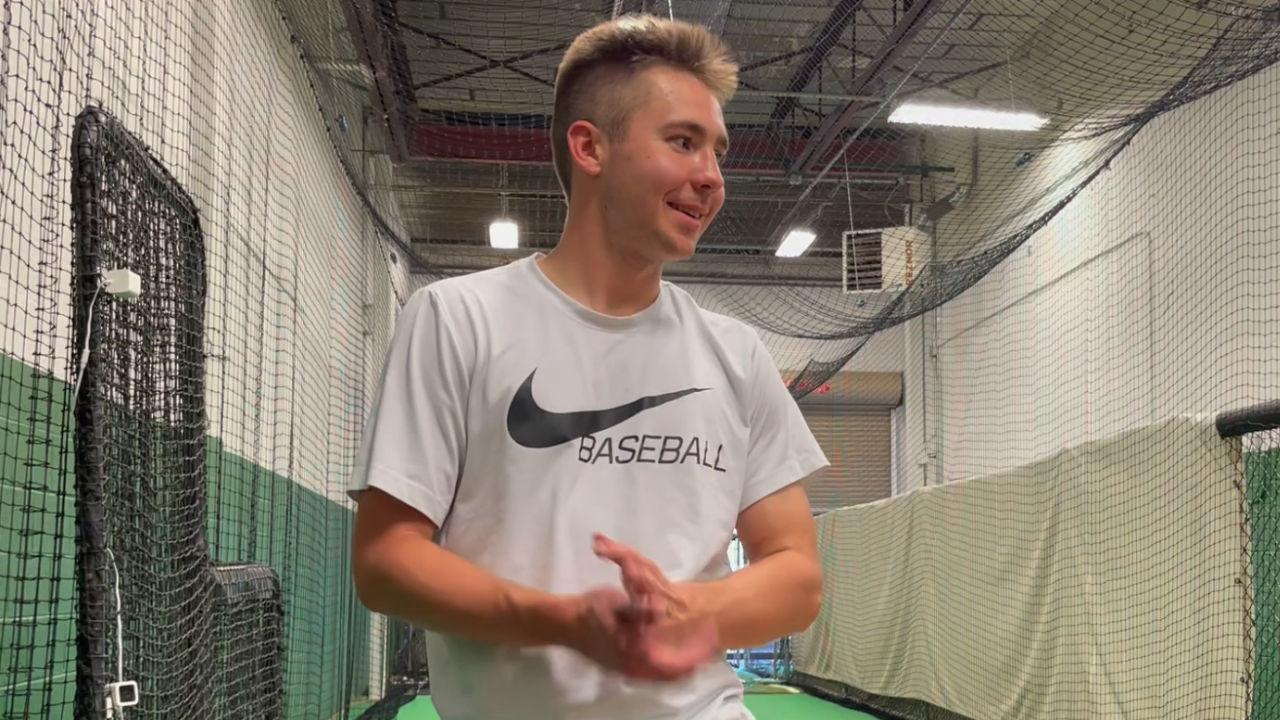
Three years later, he improved enough to sign with the University of Pittsburgh. His focus is now on pitch design as he tries to create a more distinct breaking ball from his fastball. At Pittsburgh, he didn't have access to working pitch-tracking tech. He's hoping to transfer to a mid-major Division I program with a strong business school and focus on pitching development.
Curran's father knew he needed to throw with more velocity if he was to reach his goals of making the varsity team at Mt. Lebanon High and pitching in college. Like Colcombe, he was one of Pilewski's earliest clients, arriving in the fall of 2017 as a high school junior.
While he'd taken private lessons about once a week, his throwing between those appointments was irregular, so Pilewski put him on regular throwing and weight-training programs.
"Beginning of junior year, when I first came in here, I was 79 (mph). For my high school tryouts, I was 83. That was over six months," Curran said. "I had a really good year, junior year, and I attribute it to working on velocity."
He became a two-year letter winner and signed with Division II Seton Hill. More and more players began walking through Pilewski's door. They all want to get better. And they are curious.
After emerging from the restroom with pristine hands, we were ready for a sticky substance recipe that is widely used in professional and college baseball, one Shildt ranted about all pitchers using: a mix of sunscreen with rosin. And it's a specific sunscreen many are using, the BullFrog Water Sport variety that boasts of adhering to wet skin and that "goes on clear," appealing words for pitchers seeking an edge.
Out of curiosity, I asked that we begin with just BullFrog sunscreen, but we found that it had the opposite effect. On his first fastball, Curran's rpm declined by 300 rpm from his baseline.
"I should use that on a splitter," he said.
Curran might be onto something. When you think back to the days of Gaylord Perry and spitballs and Vaseline balls, pitchers seemingly wanted the baseball to squirt out of their hands rather than stick to them. Those substances, like the BullFrog by itself, reduce spin. That could help the performance of low-spin pitches like sinkers and changeups. But we were trying to add spin.
Today's pitchers, though, are using BullFrog in conjunction with rosin.
Curran slams the rosin bag into the mound platform again to force out some of the powder. He collects the dust on his right hand and takes his index and middle fingers to his glossy, BullFrog-coated left forearm. He works the two ingredients together in his hand.
"There is a bit of tack to it right away," he says.
Colcombe follows a similar procedure. They go through their fastball and breaking ball throws. But something's not right. The results aren't much different from their results from their baseline. We must be screwing something up. Pilewski FaceTimes with one of his minor-league clients, who's pitching in an NL farm system.
"You put a shit ton on and then you just rosin the shit out of it," the professional explains. "Then it should be much stickier than rosin … grab a ball and it should not move on your hand."
Curran and Colcombe coat their forearms in BullFrog and pound more rosin out from the bag. They combine the two into a lather. They go into their throwing motion. Curran's fastball jumps up 200 rpm but it's still no better than rosin alone.
I try my hand at it. There's a tackiness to the combination, but I'm not sure I've blended it correctly. The results are middling. Perhaps with more time we could get it right, but it's time to step up our stickiness.
Pilewski still has his pro client on FaceTime, and he explains that we'll soon be moving onto pine tar, Cramer Firm Grip, and - the main event - Spider Tack. His client says he's aware of batters using Firm Grip more than pitchers. He says hitters are spraying it on their bat barrels in the hope that a millisecond of stick will give their fly balls and line drives more backspin and carry.
"The only thing that will get you with pine tar is it's visible," he said. "You have to be very careful with what you put pine tar on. On my glove, I use Spider Tack. It doesn't show up. But using pine tar would show up because it's shinier."
Pilewski's also texting with a couple of his buddies, fellow outsiders he formed a bond with during his self-learning quest. Among them is Barton Smith, a Utah State mechanical and aerospace engineering professor, known in nerdy baseball circles for his work on exploring how a baseball's seams create turbulence to affect pitch movement. Like Pilewski, Smith's fascination with development comes because his son plays. Pilewski said Smith suggested his son try some pine tar. Smith's son looked back in horror at his father: "You want me to cheat?"
Two other former SetPro.com message board alums have opened their own facilities in Philadelphia and Cincinnati. They're regulars on an iPhone text thread, as is Harold Mozingo, a former minor-league pitcher for the Blue Jays and Royals who runs his own facility in Virginia. They're all data-based development evangelists.
"Even though there are more places like this, the original ones are a pretty close-knit group," Pilewski said.
Pilewski had never tested sticky stuff before with the Rapsodo. During a text exchange, Mozingo informed him he conducted his own experiment with a number of substances you can find in a grocery store checkout line. Pilewski recites what Mozingo shared:
Pilewski and his fellow iconoclasts are always sharing ideas, insights, and data. How do hitters stand a chance?
Pilewski suggests I be conservative with the pine tar, to squeeze out a little bit onto the plywood mound away from the pitching rubber. I do, what would be a liberal portion of toothpaste on a toothbrush. It's a deep brown. I dab my right index and middle finger in and work it into my finger tips. It immediately feels stickier than the rosin or the BullFrog and rosin combo. It's almost like a greasy maple syrup.
Curran's fastball jumped up from 24.1 rpm/mph to 24.5; his slider's Bauer Units increased from 27.5 to 30.
I reached for another baseball. I followed Curran with another one of my mid-50s fastballs.
Pilewski yelled out the rpm: "1,652!"
"There you go, Travis," Colcombe said.
My rpm/mph jumped from the 25.7 baseline to 29.5.
"Next stop, Spincinnati," Pilewski said, using a nickname coined for the Reds pitching staff last year because of its elite spin rates.
I made another throw. Pilewski again shouted out the rpm: 1,647.
We tried the Firm Grip anyway, even if it's more commonly employed by hitters. While Colcombe didn't see huge benefits, Curran did. His first fastball with the clear, sticky, rosin-based substance hit 2,432 rpm, his best to date for the day, at 85.4 mph. His baseline was 2,098.
He then snapped off a slider that seemed to have more visible bend.
"That was nasty," Pilewski said.
Curran's slider also hit a personal best for the day at 2,607 rpm. With no substance, his slider averaged 2,206. He gained two inches of horizontal movement.
The Firm Grip felt like glue in aerosol form. I hit a flat 1,700 rpm, up more than 200 rpm from my baseline. I shook my head in amusement.
We went to clean our hands one more time and prepare for the grand finale, the Spider Tack.
One of the gains Curran made from training here is that he throws his four-seam fastball with nearly perfect efficiency.
The Rapsodo showed his four-seamer was between 94 and 100% efficient during this session. That meant he was getting nearly perfect transverse spin, the type of spin that's responsible for movement, spin that's sensitive to Magnus effect. The other type of spin governing ball flight - gyroscopic - is spin like a bullet or football thrown in a spiral. It produces no movement. Most pitches have an element of both types.
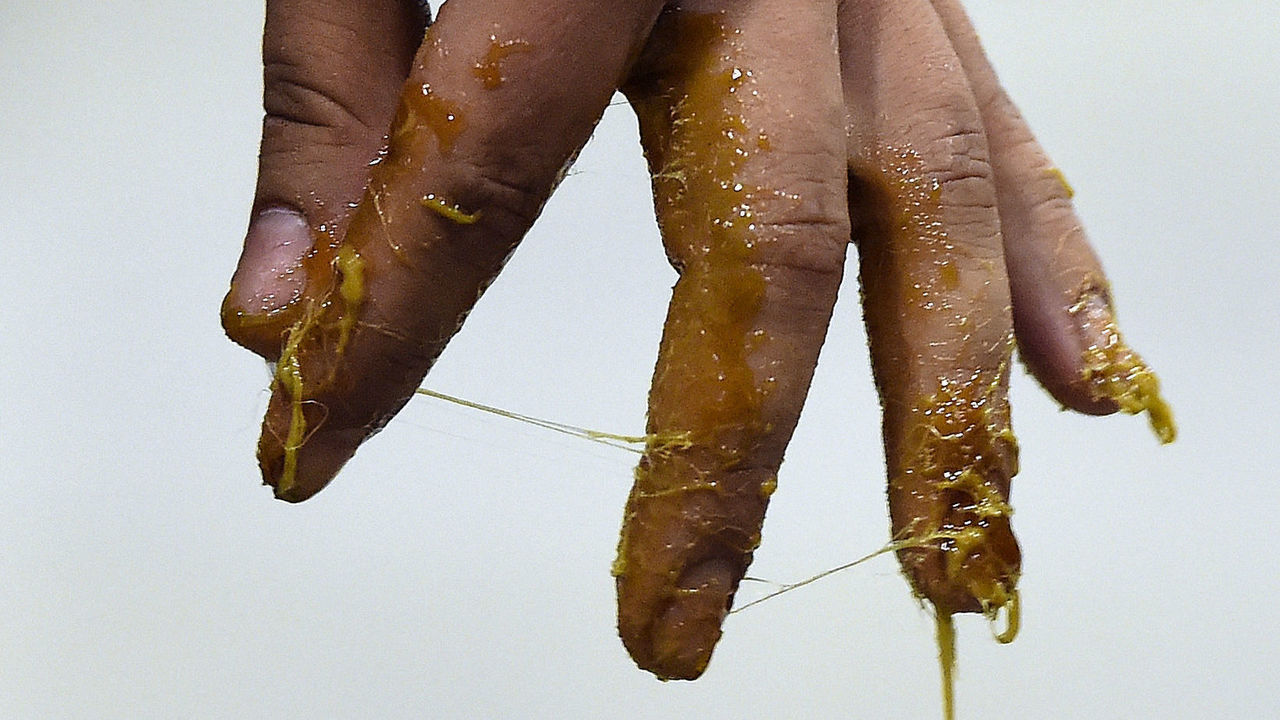
As Curran reached into the jar of Spider Tack, he was careful to not apply too much to his throwing hand. He grabbed a ball, went into a set position, and threw.
"I smelled it burning coming off your hand," Pilewski said.
The Rapsodo revealed for the first time that Curran's fastball surpassed 2,500 rpm (2,509).
"That's a good feeling," Curran said.
His pitch traveled at 85.1 mph. He threw another and hit 2,523 rpm. Curran looked pleased examining the Rapsodo data. For the first time on the day, his rpm/mph ratio surpassed 30, an absurd ratio.
At this point, some younger players training at the facility gathered around the bullpen as Curran ripped off three of the four highest-spinning sliders of the afternoon. Only his Firm Grip-aided slider spun more.
Asked one: "If your hands are extra sticky, wouldn't you throw it right into the ground?"
"You get used to it a lot quicker than you would think," Curran said.
Colcombe followed with his top spin-rate fastball of the afternoon. He looked at his hand afterward, seemingly amused by the sheer stickiness. We recalled how the minor leaguer on the phone told us Spider Tack is so sticky the ball's label will come off your fingertips.
Pilewski's intel was that some combination of rosin, BullFrog, and pine tar was most commonly used in the pros but guys were more and more "going to straight Spider Tack and calling it a day, if they hide it well enough."
Pilewski asked Colcombe and Curran if anyone else on the field could be helping pitchers. "Catchers put it on their shin guards. Do they do that for you guys?" he asked.
Curran thought about it.
"No one is going to check the catcher," he said.
An idea was born.
#OTD in 2017, Matt Szczur reached on a dropped third strike when...the ball got stuck to Yadier Molina's chest protector...
— Tony Andracki (@TonyAndracki23) April 6, 2021
2 batters later, Kyle Schwarber mashed a 3-run homer and the Cubs went on to win 6-4. pic.twitter.com/Q68wFBFIWr
It might be some time before we know what MLB is learning from its examination of balls this season. But from our experiment, we knew for sure how much assistance we were getting. Jon Heyman reported MLB owners will meet Thursday to determine if they need to increase the seriousness of sticky-stuff policing.
As for our experiment, it was my turn with the Spider Tack.
I worked the paste into my fingertips and grabbed another ball. The Rapsodo recorded the throw, and we looked toward the board.
The results appeared: 59.1 mph - and 1,810 rpm. It was nearly 400 rpm greater than the baseline throw I made earlier with no substance applied.
"That's nuts!" Pilewski exclaimed.
I'm no athlete, but it seemed too easy. It felt like cheating but also something like magic.
Travis Sawchik is theScore's senior baseball writer.